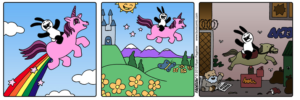We’ve spent the past month looking at words – podcasting webcomics is, after all, dependant on the hosts or interviewees talking (or else is dull listening, indeed).

My experimental podcast series “Enemy Mime” never got off the ground for some reason…
Image credit: Bandita
But webcomics are a vast and descriptive medium that doesn’t, itself, always rely on those words. We’re talking, of course, about the pantomime comic, and how they speak to us simply and effectively through their art – not their dialogue.
Pantomime as an art form goes way back – all the way to the very first forms of artwork the human race developed! You’ve no doubt seen or heard of the fantastically old cave art preserved in sites like Lascaux in France, or in cave shelters across the dehydrated centre of Australia – but what you might not have realised is that these series of drawings represent some of humanity’s earliest sequential art. Pictograms depicting ancient hunts, beasts, tribes and Gods each represented a story to the people who made them (and still tell those stories to readers today), all without words – relying solely on the art to relay the artist’s message. Over time, this form of storytelling was continued and refined – from the frescoes adorning the walls of ancient Egyptian tombs, to the marble reliefs encircling a Greek or Roman temple, to the stations of the cross placed around a Christian cathedral.

Proving humanity’s obsession with posting pictures of their food since 65,000 years BCE. Image credit: Alan Levine
More closely related to the pantomime comics we see today, the art form experienced a real resurgence around the 1400’s, when woodcuts – the art of inscribing a scene on a plate of wood, then inking that like a stamp to create a series of prints – exploded in popularity throughout Europe, being used for everything from political treatises, to illustrations in children’s books… to (often crude) cartoon scenes depicting a variety of (also often crude) material. These early versions of the comic strip evolved over the next few centuries to include labels, underwritten dialogue and eventually, speech bubbles; but through it all, the art of pantomime continued alongside.
By the early 20th century, pantomime comics had fallen out of fashion, with the art form only receiving real artistic attention in Germany, under the hands of the impressionist masters, typically also highly political or revolutionary. The art form plodded along in small press publications and Zines through to the 1960’s-80’s, with artists such as the Dutch illustrator Hendrik Dorgathen pioneering new techniques for the pantomime comic, such as word balloons filled with symbology instead of words. Later, interest in the wordless comic was reinvigorated in North American markets with the advent of the ‘graphic novel,’ with the stark and often confrontational nature of the pictures without words being used by artists such as George Walker, to explore themes such as the September 11 World Trade Centre attacks in comic form.
And then, came the internet – and with it, webcomics.
When one thinks of pantomime webcomics two standouts come to mind, both which continue the traditions of the form such as symbology, action and, in some cases, impressionism: Kristian Nygård’s Optipess and Ryan Pagelow’s Buni.
Optipess is – fitting for the Norwegian Nygård – highly representative of the European school of pantomime comics. The strip is often written with an impressionistic style, leaving the reader to draw their own conclusions as to the story depicted – whether that be humour, or horror – but also includes many of the later stylistic innovations like symbology and labelling, as well as utilising the online potential for moving comics. Nygård also periodically posts comics which reference the art form’s popular origins in woodcut, particularly with his ongoing depictions of the Cthulhu mythos.
By contrast, Pagelow’s Buni (which also posts a weekly comic on Webtoon) displays many of the North American innovations to the form. Pagelow’s cartoons are more reliant on simple visual humour than they are on impressionism, whilst also doubling down on the ‘wordless’ aspect of the comic – it is rare indeed for Pagelow to utilise a label to conceptualise an object when he can draw it. Pagelow also highly and effectively utilises the idea of word balloons with symbols, for the rare occasions the humour or cutesy-fied horror of his work needs augmentation.
What do you think of pantomime comics – love them, or hate them? Be sure to share some of your thoughts or favourites with us by posting them in the comments below or on Twitter and until next time, always remember – don’t eat the clickbait!


